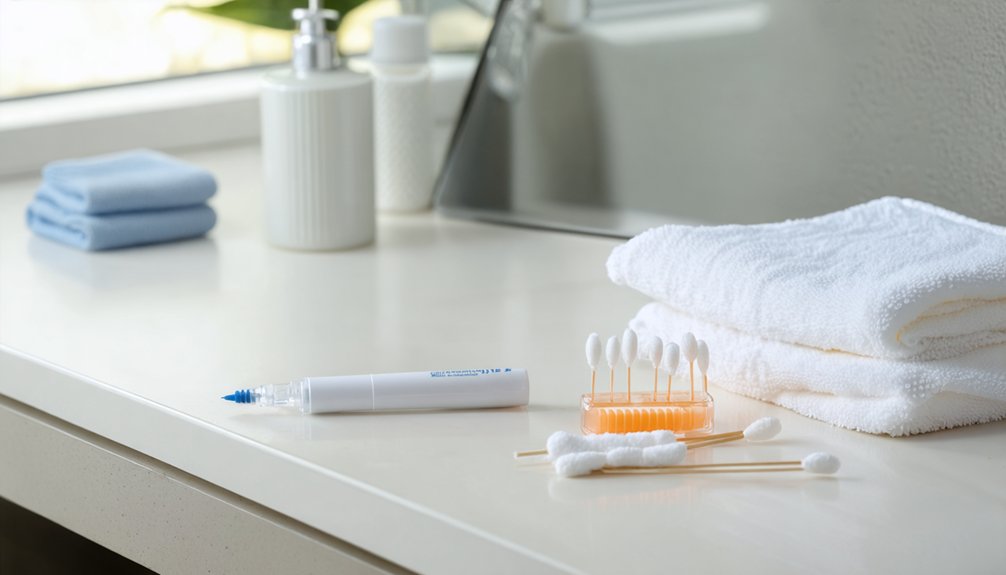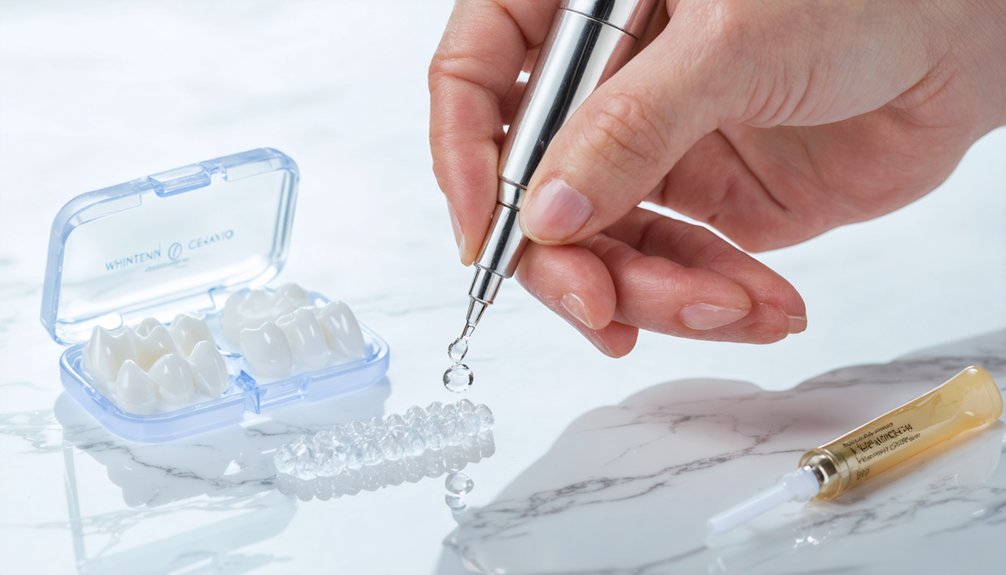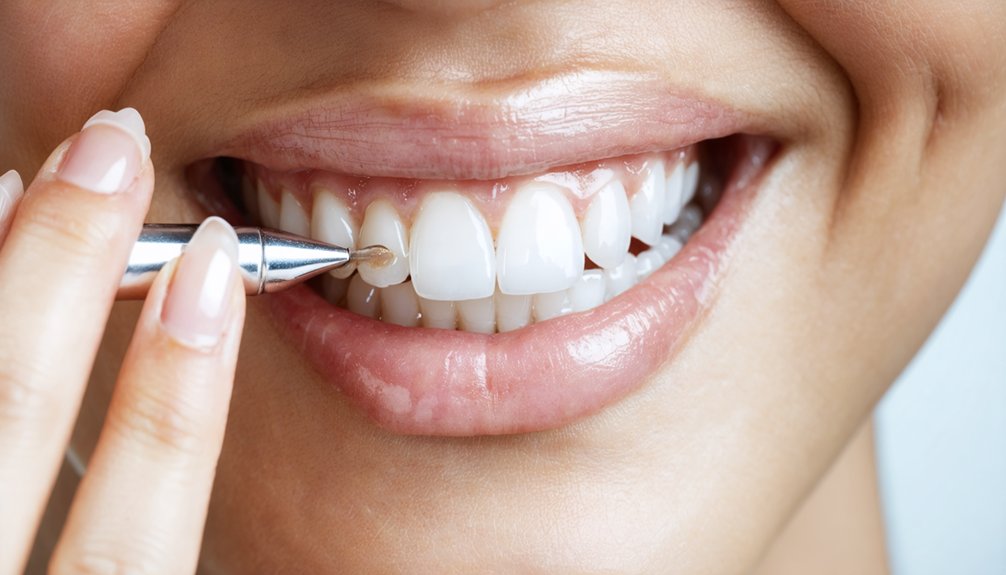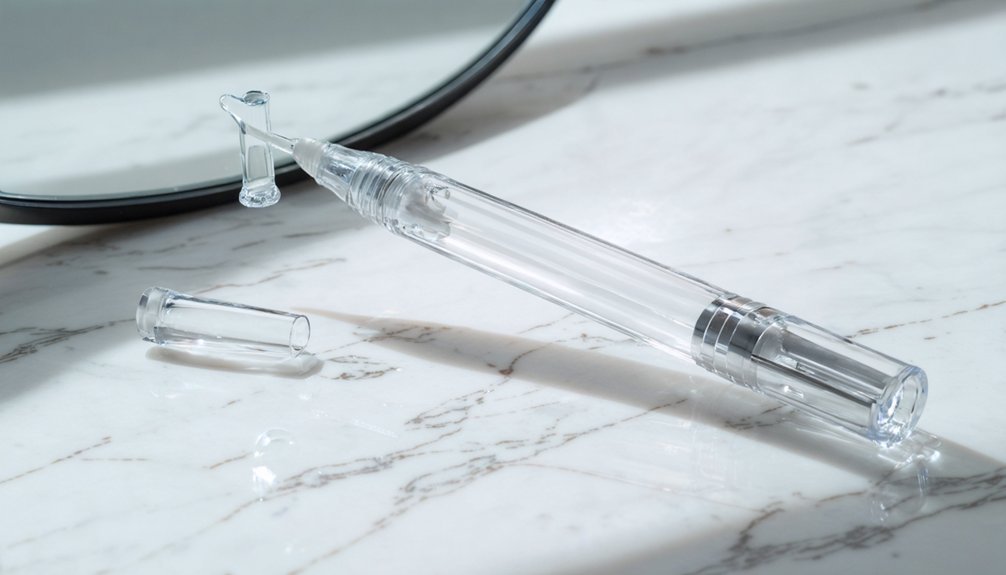For effective teeth whitening gel pen spot treatment, you’ll need to thoroughly clean and dry your teeth first. Target visible stains on front-facing surfaces using precise vertical strokes, applying a pea-sized amount per tooth while avoiding gum contact. Wait 30-60 minutes post-application before eating or drinking. Store your pen upright at room temperature between uses. Following proper technique and safety protocols will help you achieve the best whitening results.
Key Takeaways
- Clean and thoroughly dry teeth before application, waiting 30 minutes after brushing to ensure maximum gel effectiveness.
- Target visible stains on front-facing surfaces using precise vertical strokes to distribute an even layer of gel.
- Apply a pea-sized amount of gel per tooth while avoiding contact with gums and lips during treatment.
- Avoid eating, drinking, or rinsing for 30-60 minutes after application to allow proper gel penetration.
- Focus treatment on individual teeth showing pronounced yellowing, particularly upper and lower incisors and canines.
Essential Safety Guidelines Before You Begin

Before using a teeth whitening gel pen, it’s crucial to establish proper safety protocols to protect your oral health and guarantee best results.
Start by thoroughly reading the manufacturer’s instructions and verifying ingredient safety through dental professional approvals. You’ll need to conduct proper patch testing by applying a small amount to one tooth area and monitoring for 24 hours to check for sensitivity or adverse reactions.
Assess your oral health conditions carefully – avoid using whitening products if you have untreated cavities, gum disease, or severe enamel erosion. For best results, select a pen containing either hydrogen peroxide or carbamide peroxide as the active whitening ingredient.
Brush and floss thoroughly to remove debris and guarantee clean surfaces for application. Keep your teeth dry and free from any restorations that might interfere with the whitening process. Use a soft-bristled toothbrush when cleaning to protect your enamel during the whitening process.
If you notice any unusual reactions during patch testing, discontinue use and consult your dentist.
Choosing the Right Spot Treatment Areas
When targeting specific areas for teeth whitening, proper spot selection proves crucial for achieving ideal results while minimizing sensitivity risks.
Focus primarily on visible stains located on front-facing tooth surfaces, particularly your upper and lower incisors and canines that show when you smile or speak. Portable pen designs make it easy to precisely target individual teeth that need whitening most.
Prioritize dry teeth adjacent to dental work, as these areas often develop uneven discoloration. Prepare the surface by using dental floss to remove any debris or buildup between teeth.
You’ll want to concentrate the gel application on individual teeth showing more pronounced yellowing, while avoiding contact with gums, tongue, and inner lips.
Don’t apply the product to teeth with cavities, exposed dentin, or areas of gum recession.
If you’ve had previous dental work or sensitivity issues, consult your dentist before treating these targeted areas to guarantee you’re proceeding safely and effectively.
Step-by-Step Application Process
You’ll need to master the fundamentals of whitening gel pen application before focusing on spot treatments for best results.
Clean and dry your teeth thoroughly to ensure the active whitening ingredients can effectively penetrate surface stains.
The key factors for successful spot treatment include proper teeth preparation, precise gel dispensing, and maintaining recommended contact times.
Use gentle circular motions while applying the gel to ensure even coverage of targeted areas.
Following manufacturer guidelines for aftercare and maintenance will help guarantee the most effective whitening outcome for targeted areas.
Application Basics First
To achieve ideal whitening results with gel pens, proper application technique must follow a precise sequence of preparatory steps.
Begin by thoroughly brushing your teeth with fluoride toothpaste and flossing to remove all debris and plaque. Dry your teeth completely with a clean tissue to guarantee peak gel consistency and adhesion.
Before applying the whitening gel, examine your teeth for any cavities, damaged enamel, or dental work, as these areas won’t respond to treatment.
Hold the pen upright and twist the base slowly to activate the gel, typically requiring 7-15 initial turns. Shake gently to mix the components, then dispense a small amount onto the brush tip.
These application techniques maximize the whitening gel’s effectiveness while preventing waste and guaranteeing even coverage across treatable tooth surfaces. Applying more gel than needed can lead to gum irritation and uneven results.
Key Success Factors
Proper technique forms the foundation of successful teeth whitening with gel pens. Product selection and application timing greatly impact your results.
Begin with thorough brushing to remove surface debris, then dry teeth completely before application. Dispense precisely 0.5 ml of gel per treatment area using controlled strokes to guarantee even coverage while avoiding gum tissue. For enhanced results, use the pen’s rapid-drying gel formulation which activates within 30 seconds of application. The portable design makes it easy to target specific problem teeth that need extra attention.
- Apply thin, uniform layers using the pen’s applicator tip in a steady horizontal motion
- Remove excess gel immediately with a cotton swab if it contacts gum tissue
- Maintain gel contact for 20-60 minutes based on product specifications
- Avoid eating, drinking, or rinsing for 30 minutes post-application
For best outcomes, treat teeth consistently at night, allowing maximum contact time without interference from daily activities.
Monitor sensitivity levels and adjust frequency accordingly.
Common Mistakes to Avoid
You’ll compromise your whitening results if you repeatedly target sensitive areas with gel pens, as this can lead to heightened tooth discomfort and potential enamel damage.
Using too much whitening gel during spot treatments can cause gum irritation and uneven results.
Failing to thoroughly clean your teeth before application allows plaque and debris to interfere with the gel’s contact and effectiveness.
Improper storage of your whitening pen, such as leaving it uncapped or exposed to heat, can degrade the active ingredients and reduce the product’s shelf life.
Overusing On Sensitive Areas
Understanding sensitive area overuse stands as a critical concern when using teeth whitening gel pens. The primary sensitivity causes stem from hydrogen peroxide penetrating dental tissues and prolonged treatment duration beyond the recommended 15-30 minutes.
When you don’t properly control gel application, you’ll risk irritating sensitive areas and potentially causing long-term damage.
- Your gums may appear red and inflamed where excess gel makes contact
- Your teeth might develop sharp, shooting pain when exposed to temperature changes
- You’ll notice increased sensitivity in areas with thin enamel or exposed roots
- Your discomfort may persist for several days after treatment
To protect sensitive areas, apply petroleum jelly as a barrier, use minimal gel amounts, and allow recovery time between sessions.
If sensitivity develops, consider switching to lower concentration formulas specifically designed for sensitive teeth.
Skipping Pre-Application Cleaning
Beyond managing sensitivity concerns, thorough pre-application cleaning represents a fundamental step that many users mistakenly overlook.
The pre-application importance can’t be overstated, as plaque and food debris create barriers that prevent whitening agents from effectively reaching your enamel, leading to inconsistent results and potential irritation.
To optimize your whitening treatment, implement proper cleaning techniques: brush with a soft-bristled toothbrush and fluoride toothpaste, followed by thorough flossing.
Wait 30 minutes after cleaning before applying the gel to allow your enamel to stabilize. You’ll achieve more uniform whitening, reduce sensitivity risks, and extend the longevity of your results.
Remember to dry your teeth gently before application, ensuring maximum gel adherence and effectiveness in breaking down surface stains.
Improper Storage Techniques
While proper application technique is crucial for teeth whitening success, incorrect storage of whitening gel pens can greatly compromise their effectiveness and safety.
Improper temperature exposure above 77°F or fluctuating conditions accelerates the degradation of bleaching agents, while light exposure, particularly UV rays, breaks down active peroxides. You’ll need to maintain strict storage protocols to preserve your whitening gel’s potency.
- Store pens upright in an opaque container to prevent gel pooling and UV damage
- Keep products in a dark, dry place between 59-77°F (15-25°C)
- Seal caps tightly after each use to minimize air oxidation
- Replace gels within 30 days of opening, regardless of remaining product
Following these storage guidelines helps maintain gel stability and guarantees maximum whitening results for your patients while preventing potential enamel sensitivity issues.
Maximizing Treatment Effectiveness
To achieve ideal results with teeth whitening gel pens, proper preparation and application techniques must be systematically implemented.
Begin by thoroughly brushing and flossing your teeth, then dry them completely with a tissue to enhance gel consistency and adhesion. Apply the whitening gel during evening hours to maximize treatment timing and undisturbed contact with your enamel.
Start with clean, dry teeth to ensure optimal gel application. Evening treatments provide maximum contact time for better whitening results.
When dispensing the gel, twist the pen base carefully until a small drop appears. Use precise vertical strokes to distribute an even layer across visible tooth surfaces, avoiding contact with gums and lips. Maintain stretched lips during application to guarantee proper drying.
Following treatment, refrain from eating, drinking, or rinsing for 30-60 minutes to allow full gel absorption. Monitor your patients for sensitivity and adjust frequency accordingly while maintaining consistent daily applications for ideal results.
Managing Sensitivity During Treatment

Since teeth whitening gels contain peroxide-based bleaching agents that penetrate enamel, many users experience temporary sensitivity during treatment. For effective sensitivity management, you’ll need to monitor your client’s comfort level and adjust the treatment protocol accordingly.
Apply desensitizing agents containing potassium nitrate or fluoride 10-30 minutes before treatment to minimize discomfort and protect the enamel.
- Use a pea-sized amount of gel per tooth to prevent excess contact with gums
- Store whitening pens upright at room temperature for consistent gel flow
- Have clients avoid hot, cold, or acidic foods during treatment periods
- Instruct gentle brushing techniques to prevent additional enamel wear
If sensitivity persists, reduce application frequency or switch to lower-concentration formulas until symptoms subside.
Keep desensitizing products readily available for immediate relief when needed.
When to Stop or Pause Treatment
Understanding when to stop or pause teeth whitening treatment is essential for preventing adverse effects and maintaining ideal oral health.
Knowing the right moment to pause or stop whitening your teeth can protect your smile and prevent unwanted complications.
You’ll need to halt treatment immediately if you experience sharp tooth pain, persistent sensitivity, or gum irritation during application. Watch for sensitivity signs like burning sensations or white spots on your enamel, which indicate potential damage.
For best treatment evaluation, limit initial applications to 30-60 minutes and don’t exceed the recommended 7-14 day treatment period.
If you notice your whitening progress has plateaued after a week of use, consider pausing treatment. Take a 1-2 week break between whitening cycles to allow your enamel and gums to recover, especially if you’ve experienced any discomfort or sensitivity during the process.
Maintaining Your Results

Once you’ve achieved your desired level of whiteness, maintaining those results requires a systematic approach to oral care and lifestyle modifications.
For ideal teeth maintenance and whitening longevity, implement an all-encompassing daily routine that combines proper oral hygiene with protective dietary choices. Brush twice daily with whitening toothpaste, floss regularly, and use alcohol-free mouthwash to preserve your results.
- Store your whitening pen upright at room temperature for consistent gel application during touch-ups
- Wait 30 minutes after application before consuming any food or beverages
- Rinse with water after consuming staining substances like coffee or red wine
- Schedule professional cleanings every six months to remove stubborn surface stains
Avoid tobacco products, acidic beverages, and frequent snacking to protect your enamel and maintain your brightened smile.
Consider periodic touch-up treatments to address any minor discoloration that develops over time.
Advanced Tips for Stubborn Stains
When tackling stubborn tooth discoloration, specialized application techniques can greatly enhance the efficacy of whitening gel pens. For advanced gel techniques, apply short vertical strokes with a small drop at the brush tip, focusing precisely on stained areas while keeping your lips positioned away from teeth.
You’ll want to increase contact time for particularly resistant spots.
For intrinsic stain challenges, it’s essential to identify the stain type before treatment. While surface stains from beverages respond well to whitening gels, deeper discoloration from trauma or medication requires professional evaluation.
Combine your pen treatment with complementary practices like oil pulling and professional cleaning for best results.
Remember to maintain strict concentration limits of hydrogen peroxide (around 6%) to protect your enamel while effectively addressing stubborn stains.
Frequently Asked Questions
Can I Drink Water Immediately After Using a Whitening Gel Pen?
You shouldn’t drink water immediately after using the gel pen. Wait 30-60 minutes to guarantee proper gel absorption, as early water intake can dilute the whitening agent and reduce effectiveness.
Will Whitening Gel Pens Work on Dental Crowns or Veneers?
No, whitening gel pens won’t work on crowns or veneers due to dental material compatibility. These restorations are made of materials that don’t respond to whitening agents, regardless of their whitening effectiveness.
How Should I Store My Whitening Pen Between Uses?
Sharp as a tack, you’ll want to store your whitening pen upright in a dark, dry place at room temperature (59-77°F). This guarantees best storage practices and ideal gel longevity.
Can Teenagers Safely Use Teeth Whitening Gel Pens?
You’ll need to contemplate safety concerns and age restrictions. Don’t use whitening pens before age 14-16, and always get your dentist’s approval first to prevent potential tooth damage.
Should I Brush My Teeth Before or After Applying Whitening Gel?
Like preparing a canvas before painting, you’ll need to brush your teeth before applying whitening gel. Don’t brush after application – this disrupts the whitening process during its critical treatment window.
References
- https://g-p-dental.com/whitening-pens-put-to-the-test-see-what-works/
- https://drmarkshtern.com/blog/pros-and-cons-of-teeth-whitening-pens/
- https://www.trysnow.com/blogs/news/how-to-use-teeth-whitening-pen
- https://thedentaldistrict.com/blog/benefits-and-disadvantages-of-teeth-whitening-pen/
- https://health.clevelandclinic.org/is-teeth-whitening-safe
- https://www.padentalgroup.com/7-teeth-whitening-treatments-ranked-in-order-of-effectiveness/
- https://pmc.ncbi.nlm.nih.gov/articles/PMC4058574/
- https://www.colgate.com/en-us/oral-health/selecting-dental-products/how-a-teeth-whitening-pen-works
- https://nhdentistrybeverlyhills.com/press/6-of-the-best-teeth-whitening-kits-in-the-drugstore/
- https://alpenglowdentists.com/what-safety-measures-should-you-take-when-using-whitening-products/



